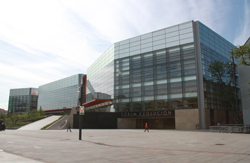
Each zone has it’s own processing and amplification. XTA processing is used exclusively for the rig in this room.
“The Adamson loudspeakers work very well with XTA and, in this case, two XTA DC1048s were the best option,” Ribo continues.
“Usually we go with a DP448, but the 1048 is perfect for installs because the switches for preset changes are on the front panel, so you can lock everything apart from the preset buttons so the end-user can’t get it wrong. It’s very user-friendly.”
Additionally, five self-powered loudspeakers from Spanish manufacturer Vieta La-8 are deployed as front fills to provide coverage for the first few rows of seating.
“The Vieta speakers aren’t in a fixed position because the front of the stage can be moved automatically. You literally press a button and it goes in and out, so you can have more or less seats depending on how large the stage needs to be and whether you need an orchestral pit or not.”
The choice of the Vieta, Ribo adds, was based on the need for a self-powered 8-inch model for this specific application.
Four Powersoft K2 amplifiers drive the Metrix and two K3 models drive the subs. The house console, a Yamaha PM5D, as well as lighting control systems, are located in a control room at the rear of the orchestra level, which is fitted with sliding glass windows.
The room is also outfitted with a monitor system headed by a Yamaha PM5D console feeding Vieta La-12s wedges.
Auditorio Secundario
The smaller auditorium has been in use since June, and is designed for lesser-scale events and corporate functions. It’s equipped with a Yamaha M7CL house console and left and right main arrays made up of five Metrix-i and two Metrix-i W cabinets hung below dual Metrix-t subwoofers.
Four Vieta La-8s deliver front fill, and more of the company’s La Series loudspeakers are also deployed as surround elements for a 5.1/7.1 system. Although not used for every application, this aspect can be brought into play for presentations or performances that require surround sound.
The cabling for 5.1/7.1 configurations is hidden in the walls, so when the venue staff wants to do something requiring 5.1 or 7.1 they place the loudspeakers as necessary. Two can be deployed as L/R side surrounds and two as rear L/R surrounds, all hung roughly 2.5 meters (about 7.5 feet) above the floor.
“When not in use the speakers can be removed so all you see is a flat wall. Then, when you need surround sound, you open up a panel, out comes the bracket, and you hang the speakers. It’s very easy and very neat, aesthetically, which was important as well.”
Here, too, XTA processing are used for the mains – two XTA DP1048s controlled via RS-485 for Metrix, with two Powersoft K2s powering the mains and two K3s for the subs.
The choice of Powersoft, Ribo says, was primarily based on its Power Factor Correction (PFC) technology, which improves performance and minimizes current draw and overall consumption. The surround loudspeakers are fed by a Denon DN-7100 surround preamplifier.
The advantages of the Metrix arrays helped SeeSound deliver precision coverage in both rooms. “The fact that two different versions are available (5-degree or 15-degree dispersion in the vertical plane) allowed us to design a very flexible system,” he continues. “The Adamson line arrays are known for their performance and overall quality, but they are also compact and discrete.”
While Burgos has other, more traditional, performance venues, the addition of a facility like the Auditorio y Palacio will allow the city to accommodate virtually any type of performance.
“Generally, older spaces are refurbished and, of course, in continental Europe there a great number of older spaces,” Ribo concludes, “but this facility will transform the cultural life of Burgos.”
Based in Toronto, Kevin Young is a freelance music and tech writer, professional musician and composer.

